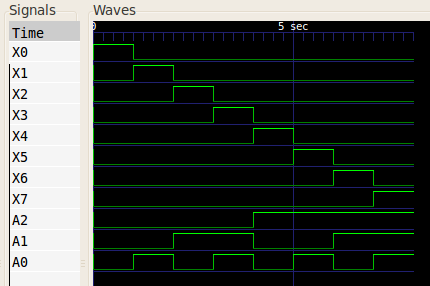Encoder
An encoder is used to convert from N inputs to an B-bit binary code where B=ceil(log2N). Here "ceil" is the ceiling function which returns the smallest integer greater than or equal to its argument. The encoder is a common example of a combinational logic circuit.
Example
The following truth table shows an octal to binary encoder.
The variables X0 to X7 are the eight input variables
and A2, A1, and A0 form the 3-bit output binary code — ceil(log28)=3.
As can be seen, only one input variable has the value 1 and all others are 0.
This isn't always the case as some encoders employ a priority scheme, e.g. if X5 and X3 were 1 then
X3 would be ignored. This would be an example of a priority encoder.
Note that some encoders have inputs that are the dual of this example, i.e. only one input variable has the value 0
and all others are 1.
X0 |
X1 |
X2 |
X3 |
X4 |
X5 |
X6 |
X7 |
A2 |
A1 |
A0 |
|---|---|---|---|---|---|---|---|---|---|---|
1 | 0 | 0 | 0 |
0 | 0 | 0 | 0 |
0 | 0 | 0 |
0 | 1 | 0 | 0 |
0 | 0 | 0 | 0 |
0 | 0 | 1 |
0 | 0 | 1 | 0 |
0 | 0 | 0 | 0 |
0 | 1 | 0 |
0 | 0 | 0 | 1 |
0 | 0 | 0 | 0 |
0 | 1 | 1 |
0 | 0 | 0 | 0 |
1 | 0 | 0 | 0 |
1 | 0 | 0 |
0 | 0 | 0 | 0 |
0 | 1 | 0 | 0 |
1 | 0 | 1 |
0 | 0 | 0 | 0 |
0 | 0 | 1 | 0 |
1 | 1 | 0 |
0 | 0 | 0 | 0 |
0 | 0 | 0 | 1 |
1 | 1 | 1 |
Verilog
Below is the Verilog code for a structural model of an octal to binary encoder:
module octal_encoder(A2, A1, A0, X0, X1, X2, X3, X4, X5, X6, X7);
output A2; // Output binary code most significant bit
output A1; // Output binary code middle bit
output A0; // Output binary code least significant bit
input X0; // Encoded to 000
input X1; // Encoded to 001
input X2; // Encoded to 010
input X3; // Encoded to 011
input X4; // Encoded to 100
input X5; // Encoded to 101
input X6; // Encoded to 110
input X7; // Encoded to 111
or(A0, X1, X3, X5, X7);
or(A1, X2, X3, X6, X7);
or(A2, X4, X5, X6, X7);
endmodule
A simulation with test inputs gave the following wave form:

References
Kleitz, W. Digital Microprocessor Fundamentals. 3rd Edition. Prentice Hall, 2000.
Mano, M. Morris, and Kime, Charles R. Logic and Computer Design Fundamentals. 2nd Edition. Prentice Hall, 2000.